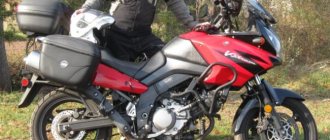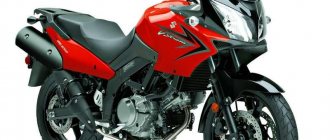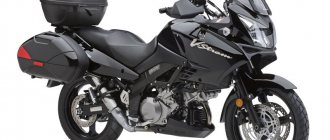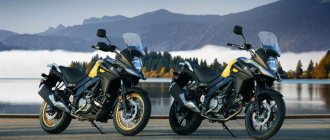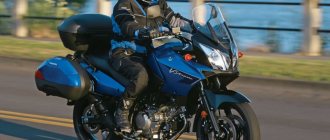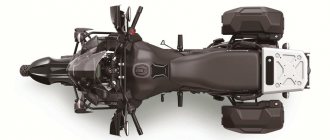Suzuki V-strom 650 xt 2018
When it comes to full-size touring enduros, you usually imagine a powerful bike that can intimidate some people before it's even lifted off the stand. Will I be able to handle his weight? What if he falls and I don’t pick him up? Can I handle its power? These questions are often found in people’s heads and on forums.
Medium tourenduros look much more attractive in this regard. They are quite large, but not menacingly huge; fast, but do not cause complexes among sportbike owners, and they are also cheaper to operate. The Suzuki V-Strom 650 XT is the newest entrant into this ever-expanding segment, and it's quite the player.
Design and ergonomics of the Suzuki V-Strom 650 XT
Based on the looks of its older brother, the Suzuki V-strom 1000, 650 XT looks like a slightly smaller version of it. This is purely a matter of taste, but personally, in my opinion, he looks extremely... how can I say... pragmatic, or something. Functional. Let's stick to "functional".
From its beak to its minimalist tail, the Suzuki V-Strom 650 XT looks ready to take on rougher terrain. At the same time, when it’s clean, it looks damn bright - for example, those gold rims that complement the canary yellow color of the big tank really “sell” it in that color. Well, unless of course the boring white tank and black rims seem more attractive to you.
Suzuki V-Strom 650 XT
The spoked wheels are shod with tubeless rubber, and it's a win-win combination. Spokes withstand road imperfections much better than alloy wheels, and tubeless tires are easy to repair in the field. There are larger and more expensive motorcycles on which it is still impossible to install tubeless tires on spoked wheels.
Suzuki has managed to maintain a balance of on-road and off-road ergonomics. The seating position is relatively low (835 mm), the footpegs are not too far back, and the handlebars are wide. So it's quite comfortable on the pavement, especially once you get used to the seat. Once off the asphalt, you will be pleasantly surprised that the shape of the large tank helps keep the bike in place with your knees, and the wide handlebar makes active steering between obstacles easier. The tank became narrower, but retained the same capacity - 20 liters.
Review of the Suzuki V-Strom 1000 (DL 1000) motorcycle
I was driving and felt - this is it! Comfort, speed, sound, handling. . ugh!!! It is mine!!! And landing! You sit high! The back is straight and does not get tired! Hands on the steering wheel - comfort, no fatigue! Changing lanes is easy and precise. Handling is wonderful. In general - delight! And the engine is big! This power at low speeds responds jerkily if the gas is unscrewed carelessly, but this is a matter of habit and settings. I think this “bug” will be eliminated over time. Also, I liked driving at night! I didn't like it much before. And I don’t like driving. And here! The light of the “chandelier” illuminates the road clearly and clearly. . it’s light And because of the landing, you see exactly what is illuminated by the headlights. In general - wonderful!!!
Comfort, speed, sound, handling. . ugh!!! It is mine!!! And landing! You sit high! The back is straight and does not get tired! Hands on the steering wheel - comfort, no fatigue! Changing lanes is easy and precise. Handling is wonderful. In general - delight! And the engine is big! This power at low speeds responds jerkily if the gas is unscrewed carelessly, but this is a matter of habit and settings. I think this “bug” will be eliminated over time. Also, I liked driving at night! I didn't like it much before. And I don’t like driving. And here! The light of the “chandelier” illuminates the road clearly and clearly. . it’s light And because of the landing, you see exactly what is illuminated by the headlights. In general - wonderful!!!
I drove 600 km over Saturday and Sunday. 150 km on Thursday evening and Friday evening. Total - 750 km. Summary. A motorcycle for traveling far, easily and comfortably! The consumption is low, the engine is torquey, the wind protection rules, the saddle is a waste.
Further operation showed that a heavy enduro, such as this sofa on two wheels, should be primarily used for movement on asphalt roads and light off-road conditions a la “packed country roads” - it will be difficult to ride through the mountains and climb in the mud, because it weighs 230 kg dry condition. add here gasoline, trunks with luggage, a rider and we get a car weighing 400 kg. And it is a car, because a speed of 200 is achievable for it and is not very stressful.
add here gasoline, trunks with luggage, a rider and we get a car weighing 400 kg. And it is a car, because a speed of 200 is achievable for it and is not very stressful. Adjusting the windshield allows a 175 cm tall pilot to completely hide behind it and ride in complete comfort and bliss. In general, if you travel far and don’t want to walk like a cavalryman after the next section of the run, then this is the motorcycle for you.
Adjusting the windshield allows a 175 cm tall pilot to completely hide behind it and ride in complete comfort and bliss. In general, if you travel far and don’t want to walk like a cavalryman after the next section of the run, then this is the motorcycle for you.
So, Suzuki DL1000 V-Strom (Storm) Adventur 2012, mileage 300 miles, engine capacity 996 cc, power 98hp, V-twin engine, 6-speed gearbox. Seat height 840 cm. Weight 240 kg. Previously I was the proud owner of a V-Star650, which successfully exchanged a V-Strom.
Before I settled on Storm, I climbed a bunch of sites, read reviews, and decided on the criteria. Storm - it is a liter, with a comfortable fit, with luggage bags (trunks), but the main problem was its saddle height of 840. I am not particularly tall at 170 cm. and I was very worried whether I would be able to reach the ground with my feet =)) in the end I reach the ground with half of my foot (toes), this makes me happy, because I can hold and push the bike.
I’ll tell you about my first impressions of the trip. Engine starting is preceded by a Check; the engine starts with the clutch depressed (a feature of all Suzukis). The exhaust is pleasantly pleasing due to the presence of a V-shaped twin - a dull rumbling gives way to a menacing roar when unscrewing the throttle. gears are switched on clearly, neutral is caught even from the first (unlike Star, where the neutral was switched on only from the second). The dashboard has a tachometer, temperature, gasoline gauge, the odometer has two modes (general and trip), and there is a clock on the dashboard, which is also convenient. The handlebars are quite high, which makes the landing almost straight with a slight tilt forward. There is hand protection so that the wind does not turn your fingers into ice. The windshield, unlike the Star, is quite low, but surprisingly, the wind doesn’t blow a bit away, apparently the glass is configured in such a way that the air flows above the driver. So, I set off from ExtremeMoto and drive in the traffic along Bryansk 2, catching up with the car, clicking gears first, second…..I lower my eyes to the speedometer…100ka…, surprisingly long 2nd gear, and the speed is not felt at all. In general, I slowed down and was driving third in the traffic. Since the engine had not been run-in, I did not turn the engine above 4000.
in motion the motor is generally as light as a 125 =)) and another thing that made me go nuts is the acceleration... in comparison with a 650 drag, this is actually something, just hold the steering wheel, otherwise it will jump out. I drove to the garage, said good night to my new friend and went home. The positive impression was further reinforced by the presence of two original side cases, which can be easily removed by turning a key. There is also a central textile back bag, which is also very comfortable, it has a whole bunch of different pockets and there is a plastic insert inside so that it keeps its shape. The bag can be easily removed and installed, and is attached to straps with Velcro.
I wanted a NEW universal car that could drive in the city, clear traffic jams, maintain cruising speed of 140-150 on the highway, not be afraid of our roads and potholes, could drive off the asphalt and crawl a little along a country road.
I looked at the Honda Transalp and was put off by the price, soft suspension and carburetor. I looked at the Honda Varadera - a good motorcycle for everyone, but 1.5 times more expensive than the Susa. I looked at the KTM - well, it’s not very good, IHMO, it’s comfortable in the city, there’s no speed on the highway, no vibration, no price. In short, the car costs more than the show-offs... TyGyDym (TDM-900) - scared away by the age of the design. After all, he is almost a grandfather...
After the break-in, I began to look at what kind of beast I got... Power and torque - POWER! It pulls great already from 2500 rpm; on the highway, if 6th gear is engaged, then it is better not to drop below 3800-4000. Handling in the city - I’m very happy with the second-hand car after Transalpa. At speeds the motorcycle is stable up to 170 km/h. Then begins an easy walk along the motz track and the front wheel “bounces”. Maybe it's because of the rear case...
Adjustable windshield - there are three positions, but I still haven’t chosen which one is better... In the lower one - it blows in the face. In the upper area behind you, turbulence begins. Average is a compromise between turbulence and howling wind in your ears. This is how I drive with the glass in the middle position, but I will experiment with the automatic layout. What I really don’t like is NO protection for the knees from air currents. If there is wind, cold and rain, then the knees die first. Such is the aerodynamics of the motsa. It also spits streams of water right into the shoes when driving through puddles. Transalp did not have such vile habits!
In the upper area behind you, turbulence begins. Average is a compromise between turbulence and howling wind in your ears. This is how I drive with the glass in the middle position, but I will experiment with the automatic layout. What I really don’t like is NO protection for the knees from air currents. If there is wind, cold and rain, then the knees die first. Such is the aerodynamics of the motsa. It also spits streams of water right into the shoes when driving through puddles. Transalp did not have such vile habits!
I tried to play with the suspension, but returned to the factory settings. Here I showed laziness and would be glad to collect opinions on who has what settings. On the highway, if you keep it at 130-140, then the bike with coffee and a load consumes 6-7 liters per hundred. But if you drive 170-180 or torn mode, then 10L don’t surprise you.
In general, despite the listed shortcomings, I really like the Mots and am quite happy with it as a UNIVERSAL means of transportation.
Engine Suzuki V-Strom 650 XT
Suzuki V-Strom 650 XT is equipped with a two-cylinder 650 cc liquid-cooled engine. The engine has excellent manners, delivering excellent thrust at low and mid-range speeds, making driving in the city comfortable without the need to constantly click through gears. You can even sneak around 40 km/h in sixth without making the engine protest, and the smooth opening of the throttle when overtaking makes the bike fire without any visible strain. This is exactly the type of traction that is needed for carefree driving in city traffic. And for added convenience at low speeds, Low RPM Assist technology prevents engine stalling by automatically increasing speed in situations where the engine is at risk of stalling: when operating the clutch, or when driving at low speeds in traffic jams. An interesting feature of the Suzuki V-Strom 650 XT motorcycle is the Easy Start system, which allows you to start the engine with one short press of the starter button, automatically turning off the starter after the engine starts.
Suzuki V-Strom 650 XT
The engine is very responsive both at low and high speeds. Traction increases linearly, and the motorcycle reaches 100 km/h in 5.1 seconds, which is quite good by tourenduro standards. A smooth set of traction is no less important and convenient when off-road riding, allowing the rider to accurately dose it. And smart two-stage traction control will help out if the hand trembles and the rider lets down. The system works equally well both on the hard and wet pavements of European cities and on rain-washed rural paths. Traction control constantly monitors the speed of both wheels, the position of the throttle, and also monitors the position of the crankshaft and the number of the selected gear, and controls engine traction, shifting the ignition timing and the amount of air supplied. The two traction control modes are sensitive: the first allows wheel slip for a more advanced steering technique, while the second traction control detects the slightest deviation in rear wheel speed, giving complete confidence when driving on slippery surfaces or in the rain. Modes are switched on the left console and displayed on the instrument panel, and of course there is the option to turn off the traction control completely, a must for experienced off-road riders.
In addition to the engine's torque, it should be praised for its completely carefree nature at cruising speed. At 100 km/h, the tachometer needle reaches 4500 rpm, which means you can comfortably drive at 120-140 km/h. The quiet nature of the engine helps save fuel, and consumption in the city is around 4 l/100 km, and on the highway it reaches 3.3 l/100.
Suzuki V-Strom 650 XT
The engine complies with Euro4 emissions standards, and in the process of adapting to the tight confines of emission standards, the engine has been modified on many fronts. It received polymer-coated pistons and revisions to more than 60 other components. The polymer coating reduces friction, increasing efficiency and improving the environmental friendliness of the exhaust. Special L-rings provide improved sealing and reduce the amount of gases allowed into the crankcase. And Dual Spark technology, unique in this class (two spark plugs per cylinder), ensures the most accurate ignition. Combined with new nickel spark plugs, this technology provides improved combustion efficiency, smoother traction and reduced fuel consumption and emissions.
TEST DRIVE: Suzuki V-Strom 650XT – Adventure Class
A modest presentation at the INTERMOT-2014 exhibition in Cologne, where Suzuki paid special attention to its project in MotoGP, somehow ignored the new product - the V-Strom DL650XT, which finally looked like the familiar “tourist enduro” to the eye. They spent less than a minute on the V-Strom, immediately switching to other models... In fact, you can understand that this is not “just a restyling” only after riding the bike for several hundred kilometers.
MOTOGONKI.RU, May 12, 2015 —
Test drive Suzuki V-Strom 650XT (2015)
The Suzuki V-Strom 650 is the very option that is easy to buy and then sell, with virtually no loss in price. It has always been a popular budget bike, not too heavy for everyday city riding, but soft enough for short trips on roads of any quality with an emphasis on asphalt.
The 645 cc L-Twin does not boast high performance, but it performed the tasks of 80% of European motorcycle tourists perfectly: 300-400 km per day on the V-Strom - it’s inexpensive and comfortable! At the end of 2012, the engine, injection system and electronics were completely updated, and total optimization was carried out, thanks to which the motorcycle significantly moderated its appetite without losing any speed.
The BMW GS style beak and the 3-position SUV windshield are striking, but that’s exactly what it is - the same restyling, otherwise...
Changes to the V-Strom 650XT MY15 are aimed at those who complained about the excessive “parquet” of the motorcycle. Among the noticeable and obvious ones: restyling in a trendy manner, “like a BMW GS”, with a “beak”, as well as spoked 19-inch front and 17-inch rear wheels, shod at the factory in touring tubeless Bridgestone Trail Wing 101/152 (110 /80R19 and 150/70R17). According to the application table, they are designed for 80% road and 20% dirt, without going into liquid mud. But this change is the key one, which radically changes the character of the motorcycle.
Spoked rims with high-profile Bridgestone Trail Wing 152 tires significantly expand the capabilities of the Suzuki V-Strom 650XT
Previously, the DL650 was equipped with alloy wheels (and continues to be equipped with the DL650ABS model) and the usual inexpensive low-profile Bridgestone Battle Wing 502 tires. Motorcyclists, who were never satisfied with just clean asphalt, changed the rims and tires to spoked ones with a powerful tread and went digging. Now this is included in the basic package!
Friday, May 8, all of Moscow goes to the dacha. The Novorizhskoe highway is actually blocked towards the region. No problem for the DL650XT owner! The side of the road is free and the V-Strom wants to move along it without slowing down, the same 80-90 km/h, although under the wheels there is no longer smooth asphalt, but dust and sand. But the traffic stops on the side of the road, what next? There is a dirt road running parallel to the highway; 2-3 jeeps have already pulled onto it. So, we should go there too!
With the Suzuki V-Strom 650XT, the quality and presence of hard surface on the road does not really matter
Trail Wing tires provide high stability and grip on dusty roads and rough roads, where other types of transport rarely appear except trucks. However, they performed well in the mud: they had to drive about 500 m through wet alumina, well plowed by their predecessors. The top layer turned out to be very viscous, so that the motorcycle’s wheels sank into it up to the rims, but the V-Strom gracefully dug itself out and went on its chosen course, without even having to stand up on the pegs.
On hard surfaces, the Suzuki chassis behaves in such a way that the faster the motorcycle goes, the better the suspension absorbs bumps. The spokes provide additional shock absorption, which increases confidence in the motorcycle on any road quality. Stability on uneven asphalt is much higher than on alloy wheels with low-profile tires. Nothing comes into the steering wheel at all, except when you hit a hole or a steep ledge while braking. In the case of Suzuki, it seems that in front of an obstacle it is better not to brake at all, but, on the contrary, to open the gas even more - just jump over it!
Apart from the wheels, the chassis of the DL650XT and the road version are no different, according to Suzuki. But gusts of side wind behind the wheel of the V-Strom 650XT at a speed of 130 km/h are felt more clearly; a high center of gravity and windage are felt, especially if the central pannier is installed. And turning into turns on the Trail Wing is not so comfortable: the edge grip is noticeably worse than on the low-profile road Battle Wing.
Engine and arc protection are two accessories that need to be installed immediately and forget about problems with ground clearance forever!
Although the XT has the same ground clearance as the road version of the DL650 at 175mm, it feels like it can do more. For complete peace of mind regarding possible engine damage, we installed GIVI Trekker Fender crankcase protection on the bike and completed the picture with Hepco-Becker bars. Both add-ons are fully compatible with the 2013-14 DL650, so dealers have plenty of them in stock.
An aluminum platform with comfortable handles comes standard with the V-Strom 650XT. All that remains is to purchase the case fasteners
A durable aluminum luggage rack is included from the factory. You just need to purchase the cheapest part of the installation kit (mounting pad, for example, GIVI MonoKey) to install the central luggage case, no longer need to bother looking for an installation kit!
Original body kit for Suzuki V-Strom 650XT (2015) - top view shows how the dimensions of the tourist change
The Suzuki factory offers an original accessory - a pair of hard side asymmetrical aluminum cases with 4 fasteners and a central box. The idea of equipping the V-Strom 650XT with side cases is simple and clear: lower the weight distribution by reducing the sail; plus, the narrow panniers are really compact and durable in appearance. But, taking into account the dimensions of the “travelling” luggage, which significantly increases the working width of the rear of the bike, as well as the predominantly urban use of the V-Strom, we decided otherwise, taking a 47-liter GIVI V47 top case, which covered almost all the needs for transporting goodies. In addition to the hard case, a 20-liter GIVI removable bag with TankLock technology was installed on the tank. The GIVI XS308 bag additionally solves the issue of using a smartphone as a GPS navigator: a 7-inch tablet can easily fit under the transparent plastic window. The luggage capacity was 67 liters without increasing the dimensions of the motorcycle, which is very important when cutting through Moscow traffic jams.
And in traffic jams the V-Strom 650XT is king! The chassis on spoked wheels and high-profile tires handles any unevenness and even ruts perfectly, the motorcycle rides more confidently between the rows than most road bikes. One of the features of the 650XT is the engine's precise response to the throttle: the 32-bit processor and ECU software are tuned to give the rider full control of the bike at low and mid-range speeds - dig your way through the clay or climb inch by inch of asphalt without taking off. feet off the steps! The previous DL650 only really worked in the mid-range. New V-Strom engine with almost 69 hp. It is well controlled from 2000 rpm, but at lower speeds there is still a risk of stalling the engine.
Suzuki DL650 Engine: 645 cc, 90-degree V-Twin (L-Twin) DOHC 69 hp. and torque 69 Nm
On the highway, the V-Strom 650XT is good from 90 to 155 km/h with a cruising speed of 130-140 km/h (6th gear, 6000 rpm) - minimum vibrations, reduced consumption. After 6000, fuel consumption increases sharply. If at a pace of 90-120 km/h you can travel up to 23 km on a liter of AI-95, then after 140 km/h this figure drops by a third, to 16.5 km. Average consumption in mixed mode did not exceed 4.5 l/100 km, which in theory will allow you to travel 400 km on a tank (20 l). This seems to be true, because during the test, which in total amounted to those same 400 km, I had to refuel only once. If you drive at full throttle, you don’t have to think about refueling for at least the next 300 km, which is very, very good.
Last time, the road V-Strom 650 managed to accelerate to 199 km/h according to GPS data. The new engine is neither faster nor slower, just tuned differently and better balanced.
The Suzuki V-Strom 650XT seat is lower and provides excellent grip thanks to the use of abrasive molded leatherette
The new seat with the V-Strom logo is positioned lower and is much more comfortable in shape. The seat upholstery is grippy, no fidgeting during braking and acceleration. It looks like leather, in fact, it is molded leatherette - the fifth point on this will never sweat. The XT's riding position isn't completely upright, but leans slightly forward. The new windshield has three positions (can be adjusted with screws); for me, with a height of 176 cm, the middle (factory) position seemed sufficient to cut off oncoming air flows. In terms of comfort and ergonomics, the V-Strom is good straight out of the factory.
The dashboard is equipped with a gear indicator, which makes sense given the traditional “clarity” of the Suzuki gearbox (catching a false neutral is easy here). There is a simple hint on how to avoid mistakes when switching or instantly correct an existing situation: release the clutch a little, the gearbox shaft will make a barely noticeable movement and the synchronizer will immediately fall into place. It often helped and still helps now, not only on V-Strom models, but also on GSF.
Suzuki V-Strom 650XT instrument panel equipped with gear indicator and economizer (in km/l format)
The Suzuki on-board computer is quite simple and, apart from the gear indicator, is not equipped with any mega modern options, but it does show the volume of gasoline consumption in the “km/l” format. The computer is controlled not on the panel itself (there is only the Adjust key, i.e. setting and/or resetting data), but on the left remote control: the key is located on the back side, where the Japanese usually place the Pass “trigger” for blinking the headlight. Pressing the key rotates menu items one by one. Lighting modes are switched using the large top key, and Pass is done by pressing it... not quite familiar.
Total
Suzuki V-Strom 650XT is an excellent option for joining the so-called “adventure class” Adventure! A motorcycle that does much more than a regular road bike on 17-inch wheels with grooves. It is comfortable and soft, at the same time very easy to maintain, holistic and self-sufficient. If you are hesitating with a choice, for example, between a 2-cylinder and 1-cylinder tourenduro in the same price and weight range, the preference is definitely worth giving to the V-Strom. On his side is flexibility and availability in everything - consumables, service, repairs.
The retail price for the Suzuki V-Strom 650XT (2015) in Moscow is 570 thousand rubles, which is much lower than for similar models from other manufacturers, in particular, Honda (from 595 thousand rubles), BMW (from 650 thousand rubles ), KTM (from 670 thousand rubles) and Triumph (more than 790 thousand rubles), and other factories simply do not have cars with similar characteristics in their Russian model range.
Pros:
+ Excellent balance on the road and light off-road + Good cross-country ability + New engine and electronics tuned for precise control from the very bottom + Extreme efficiency and ergonomics + Moderately tenacious brakes with ABS, complete with tires, stop the bike on any surface + Decent ground clearance + New, chipped key: without it the motorcycle simply won’t start
Minuses:
— Suzuki-style gearbox: not very clear shifting
PS Special thanks to Nikolai Tyurin for providing the bike for testing! The first owner of this model in Russia. Enjoy your way!
Handling Suzuki V-Strom 650 XT
The Suzuki V-Strom 650 XT is based on a twin-spar aluminum frame with a conventional fork and a monoshock absorber with adjustable spring preload. Small irregularities are absorbed by the pendant with prim elegance: oh, really, this is such a trifle...
In turns, it is obviously not as precise and sharp as a supersport, but it is far from an oil barge in terms of maneuverability. It feels stable, predictable and reliable, inspiring confidence through a series of corners. Bridgestone Battlax Adventure rubber is a dual-purpose tire that provides excellent feedback on both pavement and off-road. The longer wheelbase (1560 mm) also improves ride stability, and overall the Suzuki V-Strom 650 XT handles quite well for its size. And in addition to good on-road dynamics and a gentle character, it has serious off-road capabilities and bad roads thanks to spoked wheels shod with tubeless tires.
Suzuki V-Strom 650 XT
Hi all. I decided to share a review of the Suzuki V-Strom 650 on bikecoast. The first generation of the K-4. There is no ABS. Year 2004.
This is not the first enthusiastic review, but the final one, so to speak.
This time I decided to experiment with the format of the article and do a kind of “interview with myself.” Where in the question-answer format I’ll tell you what I remember.
Carefully. Many letters.
So, let's go!
Preface
Mileage for the season is 28 thousand, mostly with a passenger and full turbo weight.
The motor came with 14 miles, and everything was original on it: tires, consumables, air vent. Except Akuma. The roads were different. And mountain serpentines and steppes. Excellent asphalt and not so good. Dead roads of Nikolaev region and nameless voles with primers. I was stuck in traffic jams in big cities. Solo went on easy off-road trips and a bunch of times he and his passenger crawled out into the woods for tea.
Didn't fall on the asphalt. There were a couple of “walls” in the sand and mud.
My height is 175, weight is 70 kg. I have enduro and elephant experience.
Are you happy with the motorcycle?
Yes!
The moto suited the tourist's needs perfectly. I took it for a specific trip Dnepr Baikal Dnepr with a passenger. And very pleased.
Why not a liter?
Understand.
It was logical to buy a liter V-Strom for driving with a passenger. More speakers, higher speed. There is no such thing as too much power. But a liter has a little more congenital sores. And its whole feature is dynamics and a confident cruiser 140. I don’t need such speeds.
Plus the DL1000 is more expensive than the DL650, it is heavier, and the cost of ownership is higher. On the forums, everyone praised the 650k, calling it a better tourist than a liter. I listened to these reviews.
Have you considered other options?
Certainly.
I searched for a long time and figured out what I wanted. I rushed from 650, 700 transalps to road workers ala 600 phaser or CB600F.
I even thought about the 700th Deville.
There were thoughts about big geese and a liter pimp.
But a month before the purchase, I decided on the displacement and class.
Mid-sized two-cylinder motorcycle. Better turendurik.
That’s how I got Herring.
Who do you recommend the motorcycle to?
Leisurely tourists who like to look around and enjoy the trip.
Can we do it together too?
Need to!
The bike certainly sags in terms of dynamics and handling. But adequate drivers rarely ride with a passenger in a wheelie. They don't do stoppies. They don't play checkers. Abrupt maneuvers are completely avoided.
For the passenger, the saddle is comfortable, there is plenty of space, and the frame is strong. The stock stock has a durable aluminum rack that is comfortable to hold on to.
Add a center pannier with a backrest and you'll ride for hours enjoying the views.
What's the maximum speed?
I don't remember the official numbers.
I pressed 160 on the speedometer. I tried to ride 140 with a passenger. I didn’t like it. There was a turbo kit, including bags for the front arches, and a light breeze. Windage and all that.
Then I thought: “I’ll get there faster.” But in fact, there were more dangerous moments and it was difficult to look around. Well, yes, I got there faster by as much as 20 minutes.
So a cruiser of 120 according to the speedometer is equal to 108–112 according to GPS. This is a convenient and economical speed. At the same time, there is a reserve for overtaking up to 145 exactly.
What is the cost?
I think 6 liters per hundred.
I climbed beyond this figure only a few times. I even saw 7.2. But it was also lower, once even 4.8, many times around 5.2-5.6. Much depends on the wind, tires, asphalt and driving style. I love waterproof bags, so the windage is high, plus I often travel with a passenger, so I calculate the consumption at 6. I spoke with the guys who are “strut guides”; many estimate the consumption at 5.5
How long is the reserve?
There is a fuel sensor on the strut.
When one stick starts flashing, it is a conditional reserve. If you believe the official figures, we have another 2.5 liters. We calculate 2.5 l * 18 km and get 45 km.
The maximum I drove on reserve was 42 km. But this is not a cruiser, but this is the mode.
The first 25 km speed is 100 km/h. Then the “panic” mode turns on and the speed is 60-70.
What is the power reserve?
According to official figures, we divide a tank of 22 liters by a consumption of 5.5 and get the figure of 400 km on a full tank.
And I believe in these numbers if you drive 70, without a passenger, a rear trunk, on a flat straight road, without a headwind, on good gasoline.
But if we discard the “spherical horse in a vacuum” we get 250 - 300.
250 km is always there
Once I was already preparing to push the bike. But I was lucky and came across a gas station. Then 20.5 liters fit into the tank. The mileage figure was 360 km. I don't remember more precisely.
What kind of gasoline?
95th
What roads are best to ride this motorcycle on?
It is better to ride any motorcycle on good roads.
Of course, if you don’t have hard enduro. )) I'll say this. The motorcycle will perform better on good and average asphalt. If you have the skills, you can drive onto the dirt. But... I really don’t recommend it.
So it’s better to completely forget about enduro?
Yes.
Forget about targeted trips to the ground. If you want to go to Mongolia and have a blast there, buy yourself a KTM and an orange cap.
The maximum off-road possibilities for stroma are to drive a dirt road or crawl through light sand to pitch a tent for the night near a beautiful forest edge.
And then you need to be able to drive on the ground. I have a WRR, I had an xr150, xr250, a 650 transalp on bad tires (metzeler car and mitas e-09 on both wheels, anyone in the know will understand where the spendthrift was driving). And I understand what to expect from a big, clumsy elephant on road tires off-road.
Plus very little ground clearance, alloy wheels, fragile plastic.
Therefore, I strongly do not recommend the soil. Even one.
At the same time, you can ride on dry voles, light sand, and gravel paths without any problems. But if you want to do it a lot, quickly, in any weather, buy yourself a different motorcycle.
Tell me about the tires
When I bought it it was a stock 2002.
I bought the motor itself in April 2019. I understood the danger of driving on such tires and didn’t put too much effort or get impudent. Therefore, I won’t say anything about my native one. But I’ll tell you about Anake 3.
Excellent tires. Buy it. Yes, she's expensive. But cool, stable and predictable on dry asphalt, in rain, heat, cold. It takes a long time to wash, wears more than 20 thousand and works until the very end.
For example, my backside has done 24 thousand and is still going strong.
I don’t recommend betting on the evil one. You will immediately want to climb into the swamps. And this is not the habitat of the Suzuki V-Strom 650
What's in the city?
If there are few traffic jams, no problem.
I went to work and did not experience any difficulties. But in the Dnieper there is a large row spacing and few plugs. The motorcycle also has an oil cooler placed forward. And he himself is a dropsy. Overheating and boiling in a traffic jam requires a lot of effort.
Plus, the bike steers very nicely and is very nimble. And you can see everything in the mirror.
What did you change from the original?
To just take the standard one, throw it away and install an aftermarket - that didn’t happen.
The standard light is excellent. The rear rack is durable. The original windshield is enough for my height, and it is also adjustable.
Oil, air filter, chain, sprockets - all these are consumables.
What about consumables?
Full of it in any motorcycle store.
From pads to plastic protection. It’s just better to order everything for the winter and in advance.
Otherwise, I always manage to get caught up with customs during the May holidays.
For example, I received crankcase protection only at the end of May. When I already drove to Odessa on the 1st May long distance.
Tell us about additional equipment
There is sw-motech crankcase protection.
She's great, she worked for every euro. Front arches, rear frames, center stand from the guys from iron-skill. Everything is great except the center stand. I threw it away somewhere in Altai.
Cycra hand protection. But I still carry spare levers. Enduro paranoia takes its toll.
Yes, I almost forgot! If you order crankcase protection from sw-motech, be sure to ask if it will fit on your arches. One of its attachment points is very specific. Through the clamp to the front arches.
If the front arches are not from sw-motech, it may not fit.
For example, I didn’t get up. I had to make this same clamp from a 1.5 mm iron plate, rubber and bolts.
What else do you want to put in?
I want a nickel.
It's also a footrest extender. Aluminum steering wheel and spacers for it.
Heated steering wheel grips.
In principle, all this is from the series: “I’ll bet if I have extra money.”
Some people also install a remote fine filter in the fuel line.
What can you say about casting and tubeless?
I love endurics.
This is just right for our roads. All of them have spokes and a camera, this is a kind of standard and very correct. I drove on these wheels for a long time and got used to them. At first, casting scared me. Especially after a bunch of cases when road bikes flew into a hole and... we had to look for a tow truck.
I will say this, on the 650k I flew into potholes several times. Nothing bent or fell off. So if you don’t purposefully endurve over rocks and logs, there won’t be any problems. The rims are strong.
And tubeless is very convenient.
I had a puncture in a long-distance car, which I sealed in about 10 minutes. Without beading, right on the wheel. With reading the instructions and calming down the second number.
Then I spent another forty minutes looking for a pump in the village. I had a bicycle pump, which I could not use to pump the chamber up to 2.9 atmospheres.
Seriously. 10 minutes! Those who rode a camera and “glued it in the fields” will appreciate it.
Tell us about the disadvantages of the motorcycle and its birth sores
I already talked about clearance.
It's not enough for me. One is still tolerable. And when driving together it is a disaster. You have to drive through speed bumps very carefully. A long base is a disadvantage here. The preload is turned to maximum. It helps, but overall it doesn’t change the picture. It might make sense to check if the rear shock absorber is alive. And think about ordering progressive special springs.
I also discovered play in the rear sprocket.
Will explain.
There are three bearings on the rear axle. Two for the wheel, one for the star. The implication is that this will extend the life of the node and blah blah blah.
In fact, the bearing for the rear sprocket is 1 mm smaller in depth. Less from the factory. The manufacturer intended it that way.
This gives some play. It’s not critical and you can drive. But it made me nervous for half the trip. Also, there is a tricky non-standard bearing. You won’t be able to find bearings like the ones on the 650th transalp in any store at half a glance.
There are few front brakes and they are not informative. The highway is dear. The fluid has been changed and the brakes have been bled. Does not help. It might make sense to install reinforced hoses or change the oil in the fork or adjust the front suspension.
The standard set of keys does not have a hexagon (10 or 12 mm, I don’t remember exactly). Without it, you will not unscrew the front axle or remove the wheel, for example, to change tires.
Many tire shops do not have such a key.
That's all. Thank you for your attention
If you have any questions, be sure to ask them in the comments.
I will try to find time and answer. Although I think I covered the topic in sufficient detail. Well, if you liked what you read, then you can read my other articles. Which I post on the Two-Wheel Notes website, Facebook and Instagram.
All the best.
